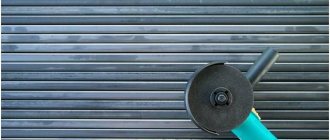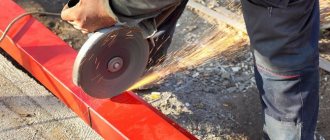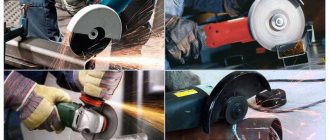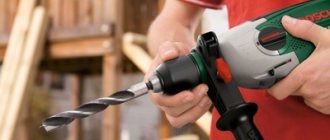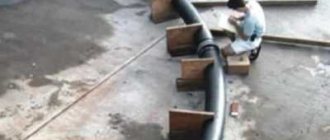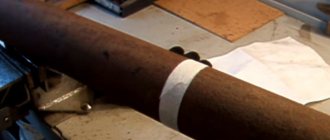Welding pipes is not an easy task, especially if you need to make sure that they do not leak during operation. But even if this is not necessary, certain difficulties often arise if it is necessary to weld one pipe into another at a certain angle.
It is quite difficult for an untrained welder to do this. To do this, you first need to mark the pipe, then cut it evenly with a grinder and weld it into another pipe. What tricks are there for this? How to quickly and correctly cut a pipe at an angle?
Tools used
A simple operation at first glance, cutting pipes in practice reveals many nuances and pitfalls. If not, just cut the tubes evenly:
- Thin-walled.
- Large diameter.
- With a bevel.
It is very important to choose the cutting method and special equipment suitable for each specific case. It is divided into individual, household and industrial.
For individual use
They are used in households, private construction and small businesses. Deal with small and medium diameters (up to 250 mm) used in systems
- Water supply.
- Heating.
- Sewer.
- Ventilation.
Such tools include:
- Cutters. Used to evenly cut polymer pipes up to 75 mm. To make an even and neat cut they have a gear mechanism. The workpiece is first clamped with a shelf clamp, which securely fixes it and prevents it from leaving the cutting line.
- Disc cutter. Suitable for ventilation and sewer polymer pipes with a diameter of up to 200 mm. The blade is not a secateur type, but in the form of a disk rolling along the surface of the workpiece. The cut is made in several turns. Not suitable for rolled metal-plastic, as it can crush the thin metal liner.
- Guillotine. The flat oblique knife moves in the guides and allows you to cut exactly the required length in one pass. It is available both with an electric drive, which provides greater productivity, and with a manual drive.
- Hacksaw for metal. A classic metalworking tool allows you to evenly cut a workpiece clamped in a vice. When using, it is important to drive the saw smoothly, with constant force and without distortion. Burrs formed after using a hacksaw should be cleaned with a file.
- Angle grinder, angle grinder. In everyday life it is called “grinder”. This universal tool can handle any materials and diameters. In order to cut a pipe with a grinder, special abrasive cutting discs are used.
- Electric jigsaw. A very popular tool among home craftsmen, it can also cut pipes, but due to the flexible blade moving to the side, you can only dream of accuracy.
- Reciprocating saw. The instrument has not yet become widespread among Russian craftsmen. The adjustable stop of the saw and its powerful blade allow you to cut off rolled products even while suspended and close to the wall.
How to cut a pipe straight
To ensure an even cut from a general-purpose tool, special devices should be used to fix the workpiece. These can be templates, vices or miter boxes. In addition, it is very important to correctly mark the future cut and, while working, make sure that the cutting line does not go to the side.
For industrial use
Such equipment is used in industries where the volume of work is large or large diameter pipes have to be cut. To cut straight, use:
- Lathe. Suitable for high-precision cutting of workpieces, chamfering, making ledges, diameter transitions and other shaped processing. Allows you to lathe and cut threads, both internal and external. The length of the part is limited by the overhang of the machine head. Diameter - overhang of the chuck jaws.
- Tape machines. They are used to cut a large diameter pipe without removing it from a trench or collector point. They also work on deformed products.
- Disc cutting machines. Highly automated installation with a pendulum saw and a workpiece feeding mechanism. Often included in the production line, it is used for high-performance cutting of rolled products into equal pieces.
- Manual disk installations. Mobile equipment is used to cut the rolled products exactly right at the installation site. Equipped with a multifunctional clamp that allows you to securely fix products of different diameters and cut them evenly without damaging the edges. The rotating work table allows you to cut smoothly at any angle. The most advanced models are equipped with an orbital welding system. This allows you not only to cut, but also to connect segments.
READ ALSO: Drain made from plastic bottles: rules and nuances of assembly
CNC Pipe Cutting Machine
Cutting technology
As a rule, the volume and complexity of work required by a home craftsman does not require the use of high-performance and expensive production-level equipment. When making a greenhouse frame, you can completely cut the pipes with a grinder or a traditional hand saw.
Each type of cut has its own nuances, and some require special tricks.
Right angle
The accuracy of the cut is largely determined by the quality of the markings. Experienced craftsmen advise marking cutting lines not with a pencil, but with masking tape, following the following sequence of actions:
- Set aside the required size and make a small mark with a marker or pencil.
- Carefully, applying to the mark, cover the part with masking tape in a circle. The edges of the paper should meet without moving. This is a sign that the paper is pasted correctly. If the edges do not meet, the tape needs to be re-glued.
- Securely fix the workpiece to prevent it from moving or distorting during work. For fixation, use a vice or clamps.
- The cut (smaller) piece of the workpiece should be left hanging so that it does not pinch the blade or disk.
- The cut starts from the top.
- The grinder disk (or hacksaw blade) is guided exactly along the edge of the masking tape, without deviating to the side.
This will allow you to cut exactly the required length.
If the diameter is large, then the markings are done in the same way, but cut in parts, in sectors of 30-60°. After cutting the next sector, the fastenings are loosened and the pipe is rotated. Then they fix it again and continue cutting from the place where the previous sector ended. To make it smooth, special attention should be paid to the beginning of the cut, avoiding steps and nicks.
Oblique incision at 45°
It is possible to cut the end of the pipe exactly at 45° without the use of complex devices. All you have to do is use your plumbing skills. You will need to do the following:
- Cut a piece of paper into a square shape.
- Fold diagonally. Learn the right isosceles triangle.
- Wrap the workpiece with a sheet so that the leg of the triangle is perpendicular to the axis, and the hypotenuse forms an upward spiral.
- Secure the sheet with tape.
- Fix the workpiece and cut along the oblique edge of the sheet. It will turn out at 45°.
There is another popular method. The end of the workpiece is immersed in a container with liquid at the required angle. You need to cut along the border of the wet and dry areas.
If you need to cut not perpendicularly, then it is better to use an old carpentry tool - a miter box.
This is a U-shaped template, in the side walls of which slots have already been made at specified angles. The pipe is placed against the wall of the miter box farthest from the master and pressed there with a hand or a hand clamp. The hand saw blade is inserted into the appropriate grooves and sawed. If necessary, cut at a different angle, you can make additional cuts in the walls of the miter box.
Techniques for cutting pipes at an angle
Non-perpendicular cutting techniques depend on the material being processed. Some techniques are suitable for plastic or thin copper - materials that are ductile and easy to process. Thick steel will require a more serious approach.
How to cut a pipe at a 45 degree angle
Plastic pipes of small diameters can be cut using specialized scissors.
Steel pipes can be cut with a grinder, but it is better to use a more precise tool - a band saw with a rotary table equipped with clamps. A tabletop disc cutting machine will also work.
When using a general-purpose tool, you will definitely have to use one or another attachment.
How to cut a pipe at a 45 degree angle
Programs for calculating cutting angles
A template for cutting at 45° can be obtained by folding a square piece of paper in half. To form patterns for other bevels, you will need to perform more or less complex trigonometric calculations. For those who safely left sines and cosines in high school and are not going to remember the formulas, there are many programs available on the Internet for calculating patterns for any necessary angle. The program performs calculations for the user-specified diameter and angle of the cut and creates an image of the pattern, which should be printed on your printer.
Important: in the print settings, select the “full size” option and disable image scaling.
Paper pattern for pipe
To cut evenly at 45°, you can make a paper pattern yourself. To do this you should:
- Measure or calculate the length of the outer circumference.
- From the corner of a sheet of A4 printer paper, draw a line at an angle of 45°. If there is no protractor, such a line can be obtained by folding together the edges of the sheet adjacent to the corner.
- Mark the circumference on it.
- This will be the hypotenuse. Add an isosceles right triangle to it. One side will be the edge of the paper, the second should be lowered perpendicular to the second edge from the set point.
- Cut out the resulting triangle - this will be the pattern for cutting pipes at an angle of 45°.
READ ALSO: How to fix a leak in a plastic pipe with your own hands
Paper pattern for pipe
It should be wrapped around the workpiece, aligning the ends of the hypotenuse. The cut will run along the line of the legs. The line should be marked with a marker or paper tape. Next, along the marked line, you can evenly cut off a piece with the required bevel.
The method is suitable for pipes with a diameter of up to 63 millimeters.
Miter box for cutting pipes
Carpenters have long used a simple but very useful device to evenly cut off the ends of bars, rectangular, round and shaped, at an angle. A carpenter's miter box is good for sawing off plastic or thin metal pipes.
You can use a ready-made one, or you can make a miter box with your own hands. Its advantage is that it can be made exactly to the size of the pipe. For production you will need:
- Cut a board 40-50 cm long and a width equal to the pipe diameter.
- Cut two boards of the same length, but wider by the thickness of the first board.
- Assemble the boards using self-tapping screws, attaching the side boards to the base so as to form a U-shaped gutter.
- In the center, mark and make vertical cuts in the side boards to the base so that a straight line drawn through them forms angles of 90, 60, 45 and 30° with the longitudinal axis of the structure.
- If necessary, make cuts at other angles.
It is better to make the side walls from stronger wood - this will extend the service life of the equipment.
Such a miter box not only determines and helps to maintain the correct cutting line and cut smoothly. It also serves as a means of fixing the pipe. It is enough to hold the pipe with your hand along with the miter box. For each diameter you will have to make separate equipment.
During operation, the slots in the side walls are also subject to wear. You need to ensure that the hacksaw blade fits into them with minimal play. In case of wear, you can cut new slots parallel to the old ones, stepping back at least 3 centimeters from them, or replace the side walls.
This miter box has the following advantages:
- simplicity of design and manufacture
- cheapness
- the ability to produce equipment for any diameter and required angle
- It is inconvenient to work with large diameters and wall thicknesses
- binding each equipment to its own diameter
- compatible only with hacksaw
Simple cutting equipment
A universal cutting machine with a pendulum circular saw is ideal for cutting thick-walled large-diameter pipes, both round and rectangular in cross-section, smoothly at an angle. Such devices work in procurement areas of small industries and on construction sites where it is necessary to accurately cut a large amount of reinforcement to size.
The circular saw together with the electric motor is mounted on a pendulum arm and can be brought into the working area with great precision and then cut in one plane.
Advanced devices are equipped with an articulated lever that allows you to change the direction of the cut. In models of the lower and middle price segments, the cutting line is oriented using a rotary table equipped with clamps for reliable fixation of the workpiece. In addition, the table can tilt sideways up to 45°. The turntable and lifting mechanism are equipped with protractors that allow you to set the angle with an accuracy of a degree.
To securely fix the pipe at a given angle, use a clamp and two steel angles with a side close to the diameter of the pipe. The short angle is secured to the rotary work table using its standard screw clamps. Fastening and cutting process step by step:
- Set the rotary table to the required cutting angle and secure it.
- Place the pipe between the corners and tighten them with a hand clamp so that the marked cutting line remains free.
- Start the engine.
- After gaining speed, smoothly bring the disk to the surface of the metal and evenly cut off the workpiece. At the beginning and end of the cut, when the cross-section of the metal being cut is maximum, you should not apply much force to the pendulum handle.
The main advantages of this method:
- high performance, also with thick walls
- even and smooth cut, requiring minimal cleaning and finishing with a file
- no need to create patterns.
There are also disadvantages inherent in this method:
- applicability to small and medium diameters
- high cost of the machine
- low mobility
- high power consumption and noise
The nuances of working with a rectangular section
To cut a rectangular profile evenly, experts recommend preparing templates in advance. The easiest way is to make templates from a steel angle of sufficient size, marked for the desired bevel. This greatly saves marking time with a large volume of similar cuts.
The corner is placed on the side of the profile pipe and the cutting line is marked along the beveled side with a marker or scriber. It is recommended to repeat it with paper tape.
Next, use an available tool to cut the profile exactly along the line.
READ ALSO: Plastic pipe for a well: installation, repair, installation of large diameter pipes for a well with drinking water
Decorative solutions
A plastic corner is the most common and affordable option for decorative finishing of various joints in the bathroom. The use of such a corner helps to hide all aesthetic defects that arise as a result of rough sealing of seams. The corner can close gaps up to 3 cm wide. It is recommended to fasten the baseboard using transparent sanitary silicone. Silicone is an excellent adhesive, provides additional sealing, and also contains antifungal additives, which is necessary when finishing a bathroom.
Border tape is the easiest and fastest way to close a gap up to 3 cm. The tape is a strip of polyethylene with an adhesive base. To glue it, you just need to degrease the work surface, measure and cut the required piece and attach it, pressing with your fingers, to the gap. Border tape without an adhesive layer is installed using silicone.
Experts recommend purchasing border tape without an adhesive base and installing it using silicone. This way it will last longer.
You can fill the gap with tiles. It is better to use tiles left over after tiling the walls. If there are no tiles left after the renovation, you can purchase several pieces of white tiles of such a size that a minimum of trimming is required. If the bathtub is white, the tiles will blend in with it and the borders will be almost invisible.
Sometimes when decorating walls with tiles, craftsmen use a decorative ceramic border. The same border can also be used to decorate the joints. Attach it to the surface using waterproof glue or liquid nails.
Precision cutting devices
Band saws are characterized by high stability of the plane of movement of the blade and cutting accuracy. They are also widely used in procurement areas of small-scale and medium-scale production. They are characterized by versatility, reliability and high performance.
For private use, the MASS company from Italy offers a compact band sawing unit. It is equipped with a manual clamping device and can smoothly cut pipes with a diameter of up to 65 mm, as well as rolled sections of any profile of the same thickness.
The rotary device allows you to set an arbitrary cutting direction from 0 to 45°. The frequency of movement of the cutting blade is up to 45 strokes per minute. An economical 370 Watt motor allows you to use a regular home single-phase power supply with a voltage of 220 V.
Industrial models (using the example of BSM)
There are special machines for industrial use to perform precise miter cutting operations. A good example: devices produced under the BSM brand. The machine manufacturer is the German company Rexinger.
True, the BSM series machines are designed exclusively for working with polypropylene pipes of fairly large diameters. Processing of products such as PP, PVC, PE, PVDF is supported.
Industrial machine for cutting pipe products made of polymers. Designed to work with large diameter products, but has equipment for processing pipes from 50 mm. The machine provides cutting in a wide range of angles
The cutting tool of the machine is a band saw, thanks to which cuts are made at angles from 0 to 67.5º. The accuracy of the process is ensured by a laser cutting recognizer.
Despite the configuration of the device for large-diameter products, you can use a special table, which can also be used to successfully cut pipes of small diameters (50 - 200 mm), which are easier to cut using a pipe cutter. A wide range of BSM devices is produced.
Application of thermal methods
In addition to mechanical methods, thermal methods of cutting pipes are also widely used. Here the tool is a gas cutter (propane or acetylene) or an electric arc welding machine. Even the thickest-walled, large-diameter pipes can be cut with a cutting torch. Productivity is also quite high. In addition, only these methods provide exceptional mobility - you can cut a pipe in a trench, basement, in places where a high-performance stationary machine simply cannot be dragged and connected.
It should be noted that thermal methods do not allow achieving high accuracy, and even cutting is not always possible. However, in a number of applications, such as operational repair of heating mains or main pipelines, it is not required. After thermal cutting, the resulting edges have to be additionally processed with mechanical tools, the cut line is leveled and the bevels are adjusted to the design values.
The thermal cutting method is also used when working with polymer pipe products. In thermal guillotines, the cut is carried out with an oblique thin cutter heated to a high temperature, sliding in guides.
The devices can also cut at an angle and very straight, but are only suitable for working with soft materials that have a low melting point.
Types of pipe taps
Before you cut a pipe into a pipe, you need to understand some issues regarding the classification of cut-ins.
Insets are divided into types depending on several factors:
- Purpose
. You can crash into plumbing, sewer and heating systems. - Pipe material
. You can cut into pipes made of plastic, cast iron, steel, polypropylene and metal-plastic. - Inset method
. In order to cut the pipe into the pipe, you can use welding or clamps.
Taking into account all these factors, we can come to the obvious conclusion - in each individual case, pipe insertion will be carried out according to its own algorithm, so they need to be given more attention.
How to cut a profile pipe evenly
It is recommended to use a bench square when marking. The required size is marked on the first side, the square is applied to the mark and a marking line is drawn. Next, without lifting the square from the angle between the edges, smoothly rotate it to the other, draw a marking line, turn it again and mark the third edge. If the lines converge on the last edge, it means the markings were done correctly.
Now you can secure the workpiece and cut the desired length with a grinder or hacksaw.
Professional marking of pipes for subsequent welding
Transferring the required dimensions from the drawing to the pipe to create a part or part of the pipeline is called marking. This process is an important and responsible operation that requires precision execution. A specialist applying marks must be able to read drawings well, as well as have a developed imagination, be able to make geometric constructions and draw developments, understand the size of allowances for subsequent processing of parts and pipes, take into account the consumption of materials, using different trims in order to save money.
VT-metall offers services:
When marking for geometric constructions of signs and lines, measuring tools and templates are used. The list of basic devices can include a ruler and a square, a compass and a tape measure, a protractor and a scriber, a level, a bore gauge, a center punch, a surface planer, a hammer and a caliper.
In addition, templates should also be used. They are used for marking parts of the same type. The material for production is mainly roofing felt, tin or cardboard.
To apply signs and marks, chalk paint with various admixtures consisting of liquid glass or wood glue is usually used. For one liter of water, it is enough to take 120 g of chalk and 7 g of wood glue. The surface is painted with this solution, then marks are applied with a scriber and, to prevent their abrasion, they are punched. To avoid inaccuracies and errors, using chalk for such purposes is unacceptable.
We recommend articles on metalworking
- Steel grades: classification and interpretation
- Aluminum grades and areas of their application
- Defects in metal products: causes and search methods
Large diameter pipe cutting
If you need to cut a large diameter pipe straight, for sewerage or at the entrance to a site, use the following tools:
- Angle Grinder. An accessible, but not very safe method. Requires a certain skill. Personal protective equipment must be used.
- Roller cutter. This is a rather complex unit, specially designed for such work. It is mounted on the pipeline, covering it from the outside. The pressure force of the cutting rollers is adjusted mechanically or automatically. Each diameter requires its own equipment.
- Gas cutter. The most commonly used method. The method is quite safe if the gas welder is sufficiently qualified and the safety rules are observed. Requires a gas cutter, acetylene or propane cylinders.
Split method of inserting pipe into pipe
For tapping into the sewer, a branching tee is usually used. The operating algorithm does not depend on what material was initially chosen to create the system.
To implement the cutting method you will need the following set of tools and materials:
- Hacksaw;
- Branching tee;
- Compensator pipe;
- Sealant;
- Pipe plug (required if the pipe will not be connected to the system immediately).
In the case of a metal riser, the installation process will look like this:
- First, the height of the adapter is accurately measured, after which it is necessary to make markings on the riser in accordance with the result obtained;
- The marked section of pipe is cut out with a hacksaw, and a tee must be installed in the freed space;
- Further work depends on what the riser is made of: for a metal riser, you will need to install a splitter by welding, and in the case of a plastic riser, you will need to mount suitable sockets, and only then assemble the structure.
How to cut a cast iron pipe
Cast iron as a material has its own specifics and differs from steel alloys in a number of physical and mechanical characteristics. Despite its high strength, cast iron is a very brittle material.
A cast iron pipe is marked in the same way as a steel pipe. Before starting work, you should place wooden blocks for support. Using an angle grinder with a cutting disc, you need to make a shallow cut around the entire circumference. Next, you need to hit the chisel inserted into the cut with great force. The product will split evenly along the saw line.
If an angle grinder is not available, you will have to make a ring cut with a hacksaw.
How to cut lengthwise
Not often, but sometimes it is still necessary to cut the pipe lengthwise. You should proceed as follows:
- Carefully mark the cutting line. Use thread, marker or masking tape.
- Secure the pipe, provide a hand support next to the pipe along the entire cutting line.
- Take your time, slowly move the angle grinder disk along the cut line and keep your hand supported, make the cut. You should constantly monitor the depth of immersion of the disk into the cut so as not to cut through the opposite wall.
How to cut thin-walled pipes
When working with thin-walled steel, there is a high risk of crushing the cut edges. To avoid this, fill the profile from the inside:
- when working with a hacksaw, insert a round wooden stick of suitable diameter
- When using an angle grinder, sand is poured inside, compacted and plugged.
How to cut a thin-walled pipe
This allows you to maintain the original shape of the pipe and evenly cut the required length.
